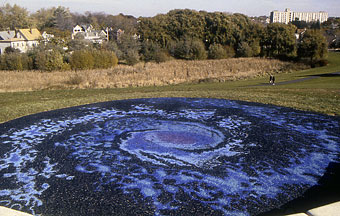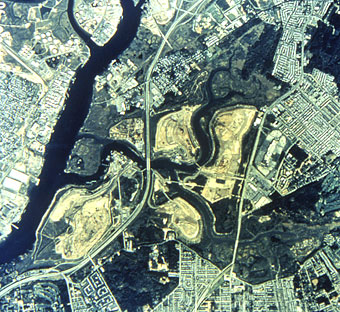
Fresh Kills Landfill – Ukeles with landscape architect Michal Pariente on top of section 1/9, gas well field
Daheny Park, Galaxy
Fresh Kills Landfill – aerial view
“Evapotranspiration: This Land Lives and Breathes” – proposal for Hiriya Landfill, Tel Aviv
9
 |
||
| Time Travel in Public Landscapes Mierle Laderman Ukeles  |
Though each is vastly different, all are what I called in 1978 when I started my work on landfills, “inner city outer space” — all share the following characteristics:
Working as an artist on any of these projects means working with others; this is definitely not a one-person show. |
|
|
|
||
|
The second site, Fresh Kills, is the largest former municipal landfill in the world; at 2,200 acres, it is the size of 2.5 Central Parks. Though Fresh Kills stopped receiving garbage in 2001; it had already been in an active process of remediation since the 1980’s, an ongoing process that will continue for up to 30 years. This includes the work of regulatory capping for closure which has also been ongoing for over a decade and will take up to the next 8 to 10 years to complete. In 2001, it was re-opened to receive what I call the Tragic Layer: Layer Four. (Layer One is the garbage; Layer Two is the remediation; Layer Three is the Master Plan for the future landscape). Fresh Kills became within days of the September 11, 2001 disaster at the World Trade Center, a federal crime site for examining, sorting, transferring and then burying the (mostly unidentified) human remains, “human dust”. This burial site occupies a special area of about 44 acres on top of the largest of four mounds at Fresh Kills. Though some parts of the landfill will become accessible to the public in the next few years, much of it will not be accessible for decades. |
 |
|
The third site, Hiriya, was closed in 1998. The landfill, occupying about 70 acres, is an extraordinarily visible table mountain because it is the lone mound jutting up about 160 feet high in an extremely flat landscape. Though almost the same age as Fresh Kills, it has only recently completed the first set of engineering assessments to determine the extent of remediation required. Thus, its process of remediation and closure has just begun. It is especially interesting because it sits in what I have called the “navel” of the whole country — at the cross-roads of Israel’s two main highways that connect its biggest cities: Highway #1 from Jerusalem to Tel Aviv and Highway #4 from Beersheba to Haifa. As well, the Hiriya mound sits inside the boundaries of the Ayalon Park which is currently held open because it is a floodplain of 2,000 acres on the edge of Tel Aviv. There is a continuing strong effort being made by a green coalition to keep this huge site open as a tremendous public park. Though each landfill is composed of the same basic material — household garbage — each was closed in different eras of environmental regulations, whether because of date or country, and is bound by different webs of regulatory constraints. Yet all three share something profound in common: all aim to be or to become safe, exciting public landscapes, and all three see themselves, very self-consciously, as international models of how degraded land can be returned to public use. And they share one more aspect: each is luckily being guided by people who are willing to persevere for decades, an extremely rare trait in this fast world; and, in addition, these leaders are incredibly devoted to the realization of these sites at an extremely high standard of public space. This, I believe, is the key to thinking that each of these places, in its own scale and uniqueness, will become something of long-lasting value. Strangely, there is a different kind and even a different shape of time adhering to each of the three projects I am currently involved with.
All three places are in a constant state of flux, yet each exists in different shapes of time. I have become a time traveler, shuttling back and forth, back and forth, in some demonic time machine from the already healed, to the healing, to the eager but unhealed. Each different kind of time has lessons for the others. To those who say, this kind of land can never become usable by the public, I point to Danehy Park. Aha! you’re wrong. Look at Danehy: it’s returned. It’s already in the present moment as a park. To those who say it will never become safe, I say, look at Fresh Kills: it has been taken from the bad old days and is slowly but ever surely becoming safer, as safe as the most advanced public safety standards demand. To those who say you can’t do it, get rid of it, it’s an eyesore, the leaders of Hiriya say come on top, right now, you can see much of the country that caused this place, you can get an understanding of where you are existentially in this country and even on this planet like no where else on earth. Sometimes I get dizzy. Yet, I am obsessed with all three sites. The key is to have a flexible sprightly attitude about time itself, in order to face what I call the morphing challenges of each site. Each project breathes the possibility of releasing our unending powers of transformation in this world and of the artist’s ability to unleash a unique process of creation for each site for with each different gestalt of communities, individuals and the geomorphology of the site itself. Each work for each of the three places, even each single component of the overall work is different. Each grows literally out of a different station in the flow of my time travel. I aim to ask in my work: can a public art process be engendered in these sites of degradation so that the public can participate in redeeming them? Can the art set out a path so that the public can re-connect with these public landscapes and belong to them in a powerful and positive way? There are thousands of these sites, all over the world, waiting for creators. |
||
|
Over the last four decades, Mierle Laderman Ukeles has created artworks that reveal the unlimited power of transformation — from changing degraded identities of workers of the NYC Department of Sanitation, to the restoration of severely ravaged landscapes, to the continuing re-birth of the individual via water immersion rituals. Her 25-year-long work as “Artist in residency” with the NYC Department of Sanitation has been defined by the Public Art Review as one of the greatest public artworks of all times. She has created site-specific works and museum installations in Korea, Holland, France, Japan, England, Israel, Los Angeles and NYC. She has received multiple awards from the National Endowment of the Arts as well as the Guggenheim, Andy Warhol, Joan Mitchell and Anonymous Was a Woman Foundations. She is currently the official artist for the Fresh Kills Landfill. |
||
|
This article was originally published in Landscape & Art, Summer 2003. |
||